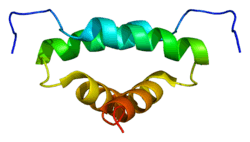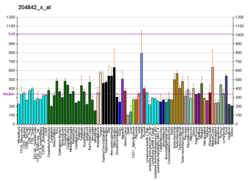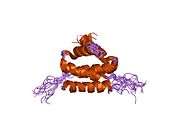PRKAR2A
cAMP-dependent protein kinase type II-alpha regulatory subunit is an enzyme that in humans is encoded by the PRKAR2A gene.[5]
Function
cAMP is a signaling molecule important for a variety of cellular functions. cAMP exerts its effects by activating the cAMP-dependent Protein Kinase, more commonly called Protein Kinase A (PKA), which transduces the signal through phosphorylation of different target proteins. The inactive holoenzyme of PKA is a tetramer composed of two regulatory and two catalytic subunits. cAMP causes the dissociation of the inactive holoenzyme into a dimer of regulatory subunits bound to four cAMP and two free monomeric catalytic subunits. Four different regulatory subunits and three catalytic subunits of PKA have been identified in humans. The protein encoded by this gene is one of the regulatory subunits. This subunit can be phosphorylated by the activated catalytic subunit. It may interact with various A-kinase anchoring proteins (AKAPs) and determine the subcellular localization of PKA. This subunit has been shown to regulate protein transport from endosomes to the Golgi apparatus and further to the endoplasmic reticulum (ER).[6]
Interactions
PRKAR2A has been shown to interact with:
See also
References
- 1 2 3 GRCh38: Ensembl release 89: ENSG00000114302 - Ensembl, May 2017
- 1 2 3 GRCm38: Ensembl release 89: ENSMUSG00000032601 - Ensembl, May 2017
- ↑ "Human PubMed Reference:".
- ↑ "Mouse PubMed Reference:".
- ↑ Taskén K, Naylor SL, Solberg R, Jahnsen T (Jun 1998). "Mapping of the gene encoding the regulatory subunit RII alpha of cAMP-dependent protein kinase (locus PRKAR2A) to human chromosome region 3p21.3-p21.2". Genomics. 50 (3): 378–81. PMID 9676433. doi:10.1006/geno.1998.5326.
- ↑ "Entrez Gene: PRKAR2A protein kinase, cAMP-dependent, regulatory, type II, alpha".
- 1 2 3 4 Alto NM, Soderling SH, Hoshi N, Langeberg LK, Fayos R, Jennings PA, Scott JD (Apr 2003). "Bioinformatic design of A-kinase anchoring protein-in silico: a potent and selective peptide antagonist of type II protein kinase A anchoring". Proceedings of the National Academy of Sciences of the United States of America. 100 (8): 4445–50. PMC 153575
 . PMID 12672969. doi:10.1073/pnas.0330734100.
. PMID 12672969. doi:10.1073/pnas.0330734100. - 1 2 Tanji C, Yamamoto H, Yorioka N, Kohno N, Kikuchi K, Kikuchi A (Oct 2002). "A-kinase anchoring protein AKAP220 binds to glycogen synthase kinase-3beta (GSK-3beta ) and mediates protein kinase A-dependent inhibition of GSK-3beta". The Journal of Biological Chemistry. 277 (40): 36955–61. PMID 12147701. doi:10.1074/jbc.M206210200.
- ↑ Lester LB, Coghlan VM, Nauert B, Scott JD (Apr 1996). "Cloning and characterization of a novel A-kinase anchoring protein. AKAP 220, association with testicular peroxisomes". The Journal of Biological Chemistry. 271 (16): 9460–5. PMID 8621616. doi:10.1074/jbc.271.16.9460.
- ↑ Carr DW, Hausken ZE, Fraser ID, Stofko-Hahn RE, Scott JD (Jul 1992). "Association of the type II cAMP-dependent protein kinase with a human thyroid RII-anchoring protein. Cloning and characterization of the RII-binding domain". The Journal of Biological Chemistry. 267 (19): 13376–82. PMID 1618839.
- ↑ Herberg FW, Maleszka A, Eide T, Vossebein L, Tasken K (Apr 2000). "Analysis of A-kinase anchoring protein (AKAP) interaction with protein kinase A (PKA) regulatory subunits: PKA isoform specificity in AKAP binding". Journal of Molecular Biology. 298 (2): 329–39. PMID 10764601. doi:10.1006/jmbi.2000.3662.
- ↑ Kapiloff MS, Schillace RV, Westphal AM, Scott JD (Aug 1999). "mAKAP: an A-kinase anchoring protein targeted to the nuclear membrane of differentiated myocytes". Journal of Cell Science. 112 (16): 2725–36. PMID 10413680.
- ↑ Dong F, Feldmesser M, Casadevall A, Rubin CS (Mar 1998). "Molecular characterization of a cDNA that encodes six isoforms of a novel murine A kinase anchor protein". The Journal of Biological Chemistry. 273 (11): 6533–41. PMID 9497389. doi:10.1074/jbc.273.11.6533.
- ↑ Vijayaraghavan S, Liberty GA, Mohan J, Winfrey VP, Olson GE, Carr DW (May 1999). "Isolation and molecular characterization of AKAP110, a novel, sperm-specific protein kinase A-anchoring protein". Molecular Endocrinology. 13 (5): 705–17. PMID 10319321. doi:10.1210/mend.13.5.0278.
- ↑ Carr DW, Fujita A, Stentz CL, Liberty GA, Olson GE, Narumiya S (May 2001). "Identification of sperm-specific proteins that interact with A-kinase anchoring proteins in a manner similar to the type II regulatory subunit of PKA". The Journal of Biological Chemistry. 276 (20): 17332–8. PMID 11278869. doi:10.1074/jbc.M011252200.
- ↑ Eide T, Coghlan V, Orstavik S, Holsve C, Solberg R, Skâlhegg BS, Lamb NJ, Langeberg L, Fernandez A, Scott JD, Jahnsen T, Taskén K (Feb 1998). "Molecular cloning, chromosomal localization, and cell cycle-dependent subcellular distribution of the A-kinase anchoring protein, AKAP95". Experimental Cell Research. 238 (2): 305–16. PMID 9473338. doi:10.1006/excr.1997.3855.
- ↑ Collas P, Le Guellec K, Taskén K (Dec 1999). "The A-kinase-anchoring protein AKAP95 is a multivalent protein with a key role in chromatin condensation at mitosis". The Journal of Cell Biology. 147 (6): 1167–80. PMC 2168084
 . PMID 10601332. doi:10.1083/jcb.147.6.1167.
. PMID 10601332. doi:10.1083/jcb.147.6.1167. - ↑ Takahashi M, Shibata H, Shimakawa M, Miyamoto M, Mukai H, Ono Y (Jun 1999). "Characterization of a novel giant scaffolding protein, CG-NAP, that anchors multiple signaling enzymes to centrosome and the golgi apparatus". The Journal of Biological Chemistry. 274 (24): 17267–74. PMID 10358086. doi:10.1074/jbc.274.24.17267.
- ↑ Li H, Adamik R, Pacheco-Rodriguez G, Moss J, Vaughan M (Feb 2003). "Protein kinase A-anchoring (AKAP) domains in brefeldin A-inhibited guanine nucleotide-exchange protein 2 (BIG2)". Proceedings of the National Academy of Sciences of the United States of America. 100 (4): 1627–32. PMC 149883
 . PMID 12571360. doi:10.1073/pnas.0337678100.
. PMID 12571360. doi:10.1073/pnas.0337678100. - ↑ Schillace RV, Andrews SF, Liberty GA, Davey MP, Carr DW (Feb 2002). "Identification and characterization of myeloid translocation gene 16b as a novel a kinase anchoring protein in T lymphocytes". Journal of Immunology. 168 (4): 1590–9. PMID 11823486. doi:10.4049/jimmunol.168.4.1590.
- ↑ Dodge KL, Khouangsathiene S, Kapiloff MS, Mouton R, Hill EV, Houslay MD, Langeberg LK, Scott JD (Apr 2001). "mAKAP assembles a protein kinase A/PDE4 phosphodiesterase cAMP signaling module". The EMBO Journal. 20 (8): 1921–30. PMC 125429
 . PMID 11296225. doi:10.1093/emboj/20.8.1921.
. PMID 11296225. doi:10.1093/emboj/20.8.1921. - ↑ Fukuyama T, Sueoka E, Sugio Y, Otsuka T, Niho Y, Akagi K, Kozu T (Sep 2001). "MTG8 proto-oncoprotein interacts with the regulatory subunit of type II cyclic AMP-dependent protein kinase in lymphocytes". Oncogene. 20 (43): 6225–32. PMID 11593431. doi:10.1038/sj.onc.1204794.
Further reading
- Cho-Chung YS, Nesterova MV (Nov 2005). "Tumor reversion: protein kinase A isozyme switching". Annals of the New York Academy of Sciences. 1058: 76–86. PMID 16394127. doi:10.1196/annals.1359.014.
- Harrich D, McMillan N, Munoz L, Apolloni A, Meredith L (Dec 2006). "Will diverse Tat interactions lead to novel antiretroviral drug targets?". Current Drug Targets. 7 (12): 1595–606. PMID 17168834. doi:10.2174/138945006779025338.
- Skålhegg BS, Landmark B, Foss KB, Lohmann SM, Hansson V, Lea T, Jahnsen T (Mar 1992). "Identification, purification, and characterization of subunits of cAMP-dependent protein kinase in human testis. Reverse mobilities of human RII alpha and RII beta on sodium dodecyl sulfate-polyacrylamide gel electrophoresis compared with rat and bovine RIIs". The Journal of Biological Chemistry. 267 (8): 5374–9. PMID 1544918.
- Carr DW, Hausken ZE, Fraser ID, Stofko-Hahn RE, Scott JD (Jul 1992). "Association of the type II cAMP-dependent protein kinase with a human thyroid RII-anchoring protein. Cloning and characterization of the RII-binding domain". The Journal of Biological Chemistry. 267 (19): 13376–82. PMID 1618839.
- Hofmann B, Nishanian P, Baldwin RL, Insixiengmay P, Nel A, Fahey JL (Dec 1990). "HIV inhibits the early steps of lymphocyte activation, including initiation of inositol phospholipid metabolism". Journal of Immunology. 145 (11): 3699–705. PMID 1978848.
- Scott JD, Stofko RE, McDonald JR, Comer JD, Vitalis EA, Mangili JA (Dec 1990). "Type II regulatory subunit dimerization determines the subcellular localization of the cAMP-dependent protein kinase". The Journal of Biological Chemistry. 265 (35): 21561–6. PMID 2147685.
- Oyen O, Myklebust F, Scott JD, Hansson V, Jahnsen T (Mar 1989). "Human testis cDNA for the regulatory subunit RII alpha of cAMP-dependent protein kinase encodes an alternate amino-terminal region". FEBS Letters. 246 (1-2): 57–64. PMID 2540040. doi:10.1016/0014-5793(89)80253-4.
- Obar RA, Dingus J, Bayley H, Vallee RB (Nov 1989). "The RII subunit of cAMP-dependent protein kinase binds to a common amino-terminal domain in microtubule-associated proteins 2A, 2B, and 2C". Neuron. 3 (5): 639–45. PMID 2561973. doi:10.1016/0896-6273(89)90274-2.
- Rubino HM, Dammerman M, Shafit-Zagardo B, Erlichman J (Nov 1989). "Localization and characterization of the binding site for the regulatory subunit of type II cAMP-dependent protein kinase on MAP2". Neuron. 3 (5): 631–8. PMID 2701845. doi:10.1016/0896-6273(89)90273-0.
- Hemmings BA, Aitken A, Cohen P, Rymond M, Hofmann F (Oct 1982). "Phosphorylation of the type-II regulatory subunit of cyclic-AMP-dependent protein kinase by glycogen synthase kinase 3 and glycogen synthase kinase 5". European Journal of Biochemistry / FEBS. 127 (3): 473–81. PMID 6293815. doi:10.1111/j.1432-1033.1982.tb06896.x.
- Hofmann B, Nishanian P, Nguyen T, Insixiengmay P, Fahey JL (Jul 1993). "Human immunodeficiency virus proteins induce the inhibitory cAMP/protein kinase A pathway in normal lymphocytes". Proceedings of the National Academy of Sciences of the United States of America. 90 (14): 6676–80. PMC 46995
 . PMID 7688126. doi:10.1073/pnas.90.14.6676.
. PMID 7688126. doi:10.1073/pnas.90.14.6676. - Pariset C, Weinman S (Dec 1994). "Differential localization of two isoforms of the regulatory subunit RII alpha of cAMP-dependent protein kinase in human sperm: biochemical and cytochemical study". Molecular Reproduction and Development. 39 (4): 415–22. PMID 7893490. doi:10.1002/mrd.1080390410.
- Cheley S, Panchal RG, Carr DW, Scott JD, Bayley H (Jan 1994). "Type II regulatory subunits of cAMP-dependent protein kinase and their binding proteins in the nervous system of Aplysia californica". The Journal of Biological Chemistry. 269 (4): 2911–20. PMID 7905481.
- Hausken ZE, Coghlan VM, Hastings CA, Reimann EM, Scott JD (Sep 1994). "Type II regulatory subunit (RII) of the cAMP-dependent protein kinase interaction with A-kinase anchor proteins requires isoleucines 3 and 5". The Journal of Biological Chemistry. 269 (39): 24245–51. PMID 7929081.
- Hofmann B, Nishanian P, Fan J, Nguyen T, Fahey JL (Jul 1994). "HIV Gag p17 protein impairs proliferation of normal lymphocytes in vitro". AIDS. 8 (7): 1016–7. PMID 7946090. doi:10.1097/00002030-199407000-00025.
- Beebe SJ, Salomonsky P, Holroyd C, Becker D (Dec 1993). "Differential expression of cyclic AMP-dependent protein kinase isozymes in normal human melanocytes and malignant melanomas". Cell Growth & Differentiation. 4 (12): 1005–12. PMID 8117614.
- Coghlan VM, Langeberg LK, Fernandez A, Lamb NJ, Scott JD (Mar 1994). "Cloning and characterization of AKAP 95, a nuclear protein that associates with the regulatory subunit of type II cAMP-dependent protein kinase". The Journal of Biological Chemistry. 269 (10): 7658–65. PMID 8125992.
- Lester LB, Coghlan VM, Nauert B, Scott JD (Apr 1996). "Cloning and characterization of a novel A-kinase anchoring protein. AKAP 220, association with testicular peroxisomes". The Journal of Biological Chemistry. 271 (16): 9460–5. PMID 8621616. doi:10.1074/jbc.271.16.9460.
- Foss KB, Solberg R, Simard J, Myklebust F, Hansson V, Jahnsen T, Taskén K (Jan 1997). "Molecular cloning, upstream sequence and promoter studies of the human gene for the regulatory subunit RII alpha of cAMP-dependent protein kinase". Biochimica et Biophysica Acta. 1350 (1): 98–108. PMID 9003463. doi:10.1016/S0167-4781(96)00152-2.
- Dransfield DT, Bradford AJ, Smith J, Martin M, Roy C, Mangeat PH, Goldenring JR (Jan 1997). "Ezrin is a cyclic AMP-dependent protein kinase anchoring protein". The EMBO Journal. 16 (1): 35–43. PMC 1169611
 . PMID 9009265. doi:10.1093/emboj/16.1.35.
. PMID 9009265. doi:10.1093/emboj/16.1.35.














